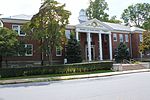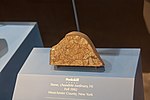Nelson Avenue–Fort Hill Historic District
Buildings and structures in Peekskill, New YorkHistoric districts in Westchester County, New YorkHistoric districts on the National Register of Historic Places in New York (state)NRHP infobox with nocatNational Register of Historic Places in Westchester County, New York ... and 1 more
Westchester County, New York Registered Historic Place stubs

The Nelson Avenue–Fort Hill Historic District is a residential neighborhood in northwestern Peekskill, Westchester County, New York, United States. It encompasses 195 contributing buildings, 3 contributing sites, and 1 contributing object and contains many late 19th-century homes in relatively intact condition.: 3–4, 6 It was listed on the National Register of Historic Places in 2006.
Excerpt from the Wikipedia article Nelson Avenue–Fort Hill Historic District (License: CC BY-SA 3.0, Authors, Images).Nelson Avenue–Fort Hill Historic District
Orchard Street,
Geographical coordinates (GPS) Address Nearby Places Show on map
Geographical coordinates (GPS)
| Latitude | Longitude |
|---|---|
| N 41.294722222222 ° | E -73.9225 ° |
Address
Orchard Street 900
10566
New York, United States
Open on Google Maps







